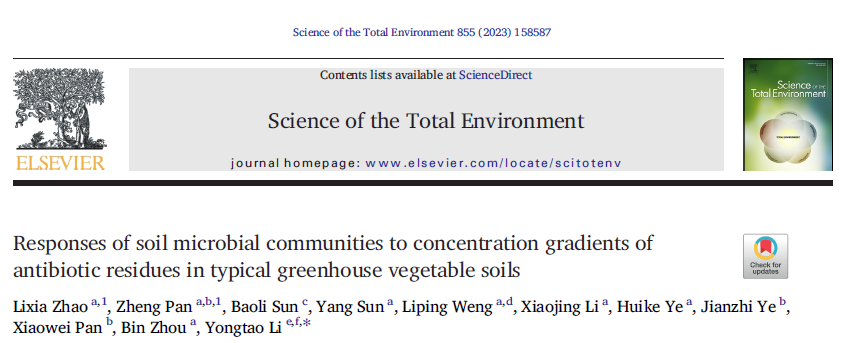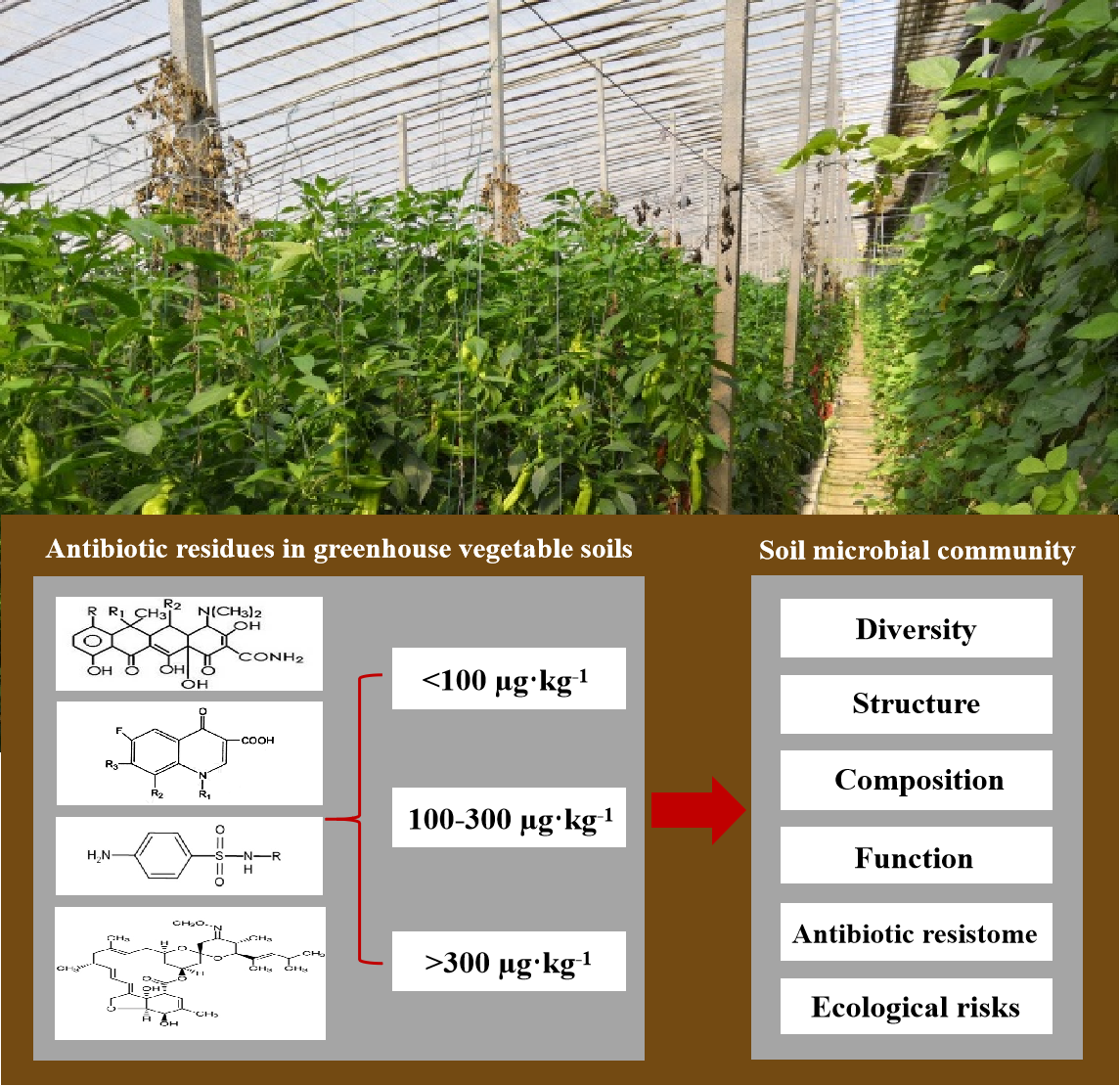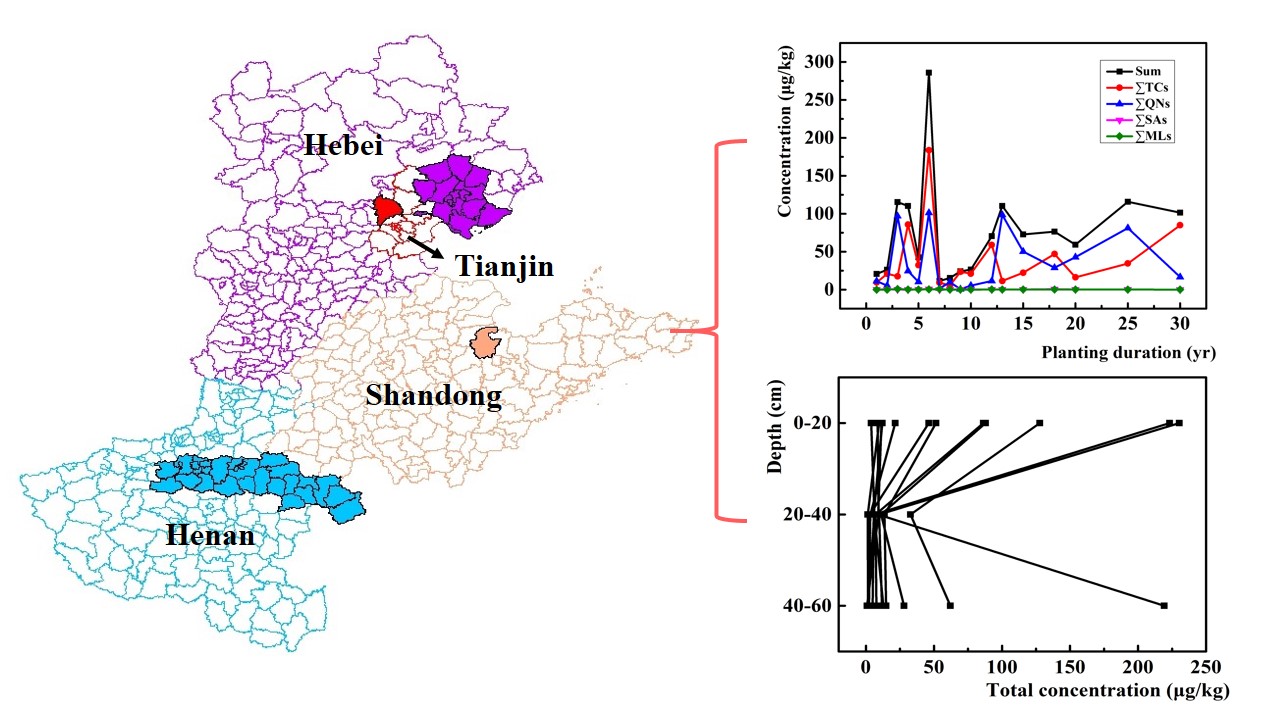Science of The Total Environment & Chemosphere揭示黄淮海地区农田土壤中抗生素污染特征与生态风险.docx
作者: 来源:农田有机污染生物消减创新团队 2022-10-21
Science of The Total Environment & Chemosphere:揭示黄淮海地区农田土壤中抗生素污染特征与生态风险

农业农村部环境保护科研监测所农田有机污染生物消减创新团队在Science of the Total Environment杂志发表题为"Responses of soil microbial communities to concentration gradients of antibiotic residues in typical greenhouse vegetable soils" 的研究论文。论文在探明天津武清设施蔬菜土壤中抗生素及其代谢产物的残留特征的基础上,揭示了自然农田环境中不同浓度抗生素残留对土壤微生物群落的响应,阐明了抗生素残留、抗生素抗性基因(ARGs)和土壤微生物群落之间的相互作用,并采用风险熵法评估了抗生素残留对土壤生态系统的潜在生态风险。研究结果将为制定土壤抗生素污染防治策略提供理论支撑。
农业农村部环境保护科研监测所赵丽霞副研究员和硕士研究生潘政为论文共同第一作者,李永涛教授为论文通讯作者。研究受到国家自然科学基金(42177034)、国家重点研发计划课题(2016YFD0800201)和中国农科院科技创新工程等项目的资助。
http://dx.doi.org/10.1016/j.scitotenv.2022.158587
Highlights
² Residues of metabolites of tetracyclines in soil were almost equal to tetracyclines.
² Higher antibiotic residues reduced soil bacterial/fungal community diversity.
² Bacterial interactions first decrease and then increase as antibiotics increase in soil.
² Antibiotic resistome occurred in soil with antibiotic residues exceeding 300 µg·kg-1.
² Weighted pollution index was used to assess mixed ecological risk of antibiotics.
Abstract
To explore the responses of soil microbial communities to concentration gradients of antibiotic residues in soil, 32 soil samples were collected from a typical greenhouse vegetable production base in Northern China in 2019. The total concentrations of 26 antibiotic residues in these soil samples was 83.24-4237.93 µg·kg-1, of which metabolites of tetracyclines were 23.34-1798.80 µg·kg-1. The total concentrations in 32 samples were clustered into three levels (L:<100 µg·kg-1, M: 100-300 µg·kg-1, H: >300 µg·kg-1) to elucidate the impacts of antibiotic residues on the diversity, structure, composition, function and antibiotic resistome of soil microbial community. Results showed that higher concentration of antibiotic residues in soil was prone to decrease the diversity and shift the structure and composition of soil microbial community. Antibiotic resistome occurred in soils with antibiotic residues exceeding 300 µg·kg-1. Interactions among soil bacteria followed the order of H >L >M, consistent with the relative abundances of mobile genetic elements. Bacteroidetes and Firmicutes were the top attributors impacting the profile of antibiotics in soil. According to weighted comprehensive pollution index of risk quotient, in 28.1% of soil samples the residual antibiotics presented high ecological risk, whereas in the rest of soil samples the ecological risk is medium. The results will enrich the database and provide references for antibiotic contamination control in soils of the region and alike.

主要研究结果:26种抗生素在设施菜地土壤中的残留浓度范围为83.24 ~ 4237.93μg·kg-1,残留主要为四环素类(TCs)和喹诺酮类(QNs)抗生素。TCs代谢产物的检出范围为23.34 ~ 1798.80µg·kg-1,与土壤中TCs的残留程度相当,值得引起重视。随着抗生素残留浓度的增加,细菌和真菌群落多样性显著降低,结构发生明显变化。放线菌门相对丰度降低,拟杆菌门相对丰度增加,真菌群落组成在门水平上变化不明显。细菌对高水平的抗生素残留产生耐药性,而高水平的抗生素残留对某些真菌具有不可逆的抑制作用。值得注意的是,随着抗生素水平的增加,细菌的种间关系先减小后增大,与MGEs的丰度一致;当土壤中抗生素残留超过300µg·kg-1时,微生物产生抗性。本文筛选了潜在的ARGs宿主菌,拟杆菌门和厚壁菌门是影响土壤中ARGs的主要因子。综合风险熵法和加权综合污染指数计算,评估了多种抗生素残留的复合生态风险,结果显示71.9%的土壤样品抗生素残留对土壤生物具有中等风险,28.1%为高风险。因此,迫切需要制定有效的措施来控制和消除农业土壤中的抗生素残留。研究结果可为全面认识农业土壤生态系统中抗生素残留的生态风险,制定土壤中抗生素残留的生态阈值提供理论参考。

2021年,农业农村部环境保护科研监测所农田有机污染生物消减创新团队在Chemosphere杂志发表题为"Temporal and spatial variability of antibiotics in agricultural soils from Huang-Huai-Hai Plain, northern China" 的研究论文。
该论文研究了20种抗生素在黄淮海地区4个省市(山东、河南、河北、天津)设施和露天土壤中的残留水平和垂直分布特征,分析了不同种植年限设施土壤中抗生素残留的动态变化,揭示了土壤基本理化性质和微生物群落与土壤抗生素残留的关系。研究结果为区域农田抗生素污染防控提供了数据支持。
农业农村部环境保护科研监测所硕士研究生潘政为论文第一作者,赵丽霞副研究员和李永涛教授为论文共同通讯作者。研究受到国家重点研发计划课题(2016YFD0800201)、中央级科研院所基本科研业务费和国家自然科学基金(41771517)的资助。
https://doi.org/10.1016/j.chemosphere.2021.129803
Highlights
² Antibiotic residues differed regionally in soils of Huang-Huai-Hai plain.
² Levels of antibiotics in greenhouse soils were higher than those in open-fields.
² The residual antibiotics in greenhouse vegetable soils showed periodical dynamics.
² Quinolones presented higher concentrations in soil of 40-60 cm than 20-40 cm depth.
Abstract
The objective of this study was to investigate the temporal and spatial distribution of antibiotics in agricultural soils of Huang-Huai-Hai Plain, which is a major agricultural producing area and economically developed region in China. In this study, 105 soil samples including 13 groups of soil profile samples (0-20, 20-40 and 40-60 cm) and 23 paired surface soil samples of greenhouse and open-field were collected from four provinces/municipality in 2018. The occurrence of 20 antibiotics, including four tetracyclines (TCs), seven quinolones (QNs), six sulfonamides (SAs) and three macrolides (MLs) were measured. The concentrations of total antibiotics fell in the range of 1.62-575 µg·kg-1, with the mean value of 68.8 µg·kg-1. TCs and QNs were dominant antibiotics in soil, accounting for 99.6% of the total concentration. Regional differences of antibiotic residues in soil were found among the four regions as well as between different cropping systems. The levels of antibiotics in greenhouse soils (3.52-575 µg·kg-1) were higher than those in open-field soils (1.62-142 µg·kg-1). In soils of greenhouse of 1-6 years old, the levels of antibiotics were higher than those with longer history (7-30 years). Antibiotics were mainly distributed in the depth of 0-20 cm. The total concentrations of antibiotics/QNs followed the order of 0–20 cm >40–60 cm >20–40 cm, due to probably their interactions with total organic carbon and associated bacterial communities. The results in the study will provide data supports for the formulation of soil antibiotic contamination prevention and control measures.

主要结论:抗生素是黄淮海平原农田土壤中普遍存在的污染物。抗生素总浓度在1.62 ~ 575µg·kg-1之间,平均值为68.8µg·kg-1,有24.1%的土壤样品中抗生素浓度超过了国际兽医协调委员会确定的抗生素生态毒性效应触发值(100 µg·kg-1)。四环素类和喹诺酮类是土壤中常见的抗生素,其中四环素、土霉素、强力霉素、金霉素、恩诺沙星、氧氟沙星和环丙沙星的残留水平较高,应引起重视。此外,20种抗生素的浓度有明显的地区差异,顺序为山东>河南>天津>河北。设施土壤中抗生素残留水平高于露天土壤,这主要是由于设施土壤中粪肥的施用量和使用频率高于露天土壤。该地区温室土壤中抗生素残留具有明显的周期动态,1 ~ 6年温室土壤中20种抗生素的浓度高于7 ~ 30年。抗生素主要分布在0 ~ 20 cm的耕作层,20种抗生素的总浓度为0 ~ 20 cm > 40 ~ 60 cm > 20 ~ 40 cm,且随着土壤深度的增加,抗生素的检测频率逐渐降低,这主要是随着土层深度增加,土壤有机质含量和微生物活性下降所致。研究结果将为制定土壤抗生素污染防治措施提供数据支持。













